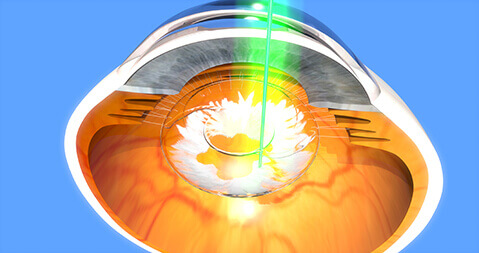YAG Capsulotomy
Secondary Membrane and YAG Capsulotomy

After modern cataract surgery with a lens implant, the back membrane of the cataract is left in place to support the lens implant. This membrane may become cloudy and cause blurred vision and sometimes patients will see streaks or halos around lights. These problems worsen with time.
This capsule has cells on it which will, in some cases, continue to produce lens fibers. These fibers cannot be laid down in an organized manner and will form little beads or “pearls” on the lens capsule, forming a secondary membrane. When these pearls accumulate in the pupil, they cause a blurring of vision similar to that of a cataract. This occurs approximately 30-40% of the time and can appear at any time after surgery, even as much as five or more years later.
Although the blurred vision produced by this membrane can be quite significant, fortunately, there is a very easy way of clearing the pupil of this cloudy capsule. During the procedure, called a YAG Laser Capsulotomy, a special laser (Yttrium Aluminum Garnet) is used. There is absolutely no pain involved in this procedure. The patient will usually notice an improvement as soon as the pupil, which is dilated, goes back to its normal size.
The Procedure:
- Is completely painless
- Does not require any pre-operative tests
- Does not require any anesthesia
- Does not need an operating room
- Takes less than 5 minutes
- Does not have any post-operative restrictions
What to Expect Before Your Procedure:
- A Registered Nurse from the Surgery Center will contact you by telephone to obtain a medical history and confirm the date and time of your procedure.
What to Expect After Your Procedure:
- No eye patch or shield is needed
- The doctor may prescribe an eye drop after this procedure
- You can resume all your normal activities
- Your eye may feel irritated, scratchy, or like something is in it
- Your eye may appear red or bloodshot, this will lessen as your eye heals
- It is common to notice an increase in floaters for the first week
- Your vision may be blurry and eyes sensitive to light following the procedure
- You will have a follow-up appointment scheduled in 1-2 weeks after the procedure
What to Watch for After Your Procedure:
- A sudden decrease in vision
- An increase in flashes of light
- A sudden increase in pain or pain not relieved by over the counter pain medication such as ibuprofen or acetaminophen
YAG Capsulotomy: After Cataract Surgery
Learn what can happen after cataract surgery with this video.

